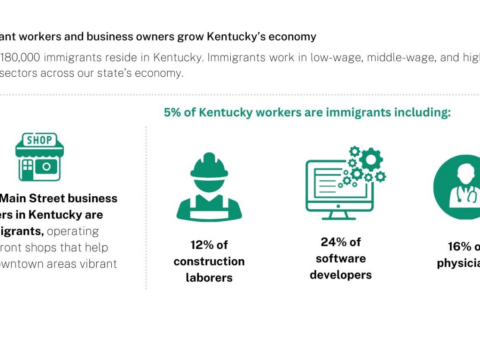The U.S. Census Bureau released new data today showing continued progress in our economy overall but a relatively large share of Kentuckians still struggling to afford the basics, especially people of color, and a lack of progress for communities in eastern Kentucky.
The data shows 17.2 percent of Kentuckians lived below the poverty line in 2017. The state’s poverty rate is an improvement from the 18.5 percent rate in 2016, reflecting ongoing gains in the economy since 2010 from the harms of the Great Recession. However, Kentucky’s poverty rate is still substantially higher than it was in 2001, when it was 15.4 percent.
In addition, the poverty rate in the 5th Congressional District of eastern Kentucky was 29.1 percent in 2017, statistically unchanged from 29.3 percent in 2016. Some barriers to economic prosperity are more pronounced in rural regions of the state due to a decline in traditional industries, a lack of jobs and state and federal disinvestment stifling economic activity.
“Our economy is continuing to recover overall from the Great Recession, but too many Kentuckians still face problems making ends meet,” Executive Director Jason Bailey said. “We need policies to improve job quality standards, such as a higher minimum wage, and direct federal and state investment in public job creation that can help rural and other areas more fully recover.”
In addition, the data released today make a strong case for protecting existing programs that help struggling Kentuckians put food on the table, get to the doctor and make ends meet – like the Supplemental Nutrition Assistance Program (SNAP), Medicaid, housing assistance and the federal EITC. The “Supplemental Poverty Measure” – which unlike the official poverty measure factors in different forms of assistance, variations in cost of living across states and expenses such as child care and out-of-pocket medical costs – showed that in 2015-2017, safety net programs lifted 116,000 Kentuckians out of poverty. Current attacks on the safety net – such as proposed (and in some cases, enacted) barriers to health coverage and nutrition assistance – threaten hundreds of thousands in the commonwealth.
Kentuckians of color face higher rates of poverty than white Kentuckians, with black Kentuckians’ poverty rate at 25.7 percent and Latino Kentuckians at 25.8 percent compared to the white poverty rate of 16.1 percent. The black and Latino poverty rates showed improvement this year, falling from 30.2 percent and 30.6 percent in 2016, respectively. But barriers to getting by and getting ahead – such as hiring discrimination, unequal educational opportunities and harmful criminal justice practices – result in racial equity gaps.
“Taking down barriers to economic prosperity for each Kentuckian will help us all,” said Bailey. “If we reinvest in communities that are still falling behind, if our criminal justice laws focus on rehabilitation and truly safe communities, and if work is compensated fairly for all workers, our whole economy can continue moving forward.”

